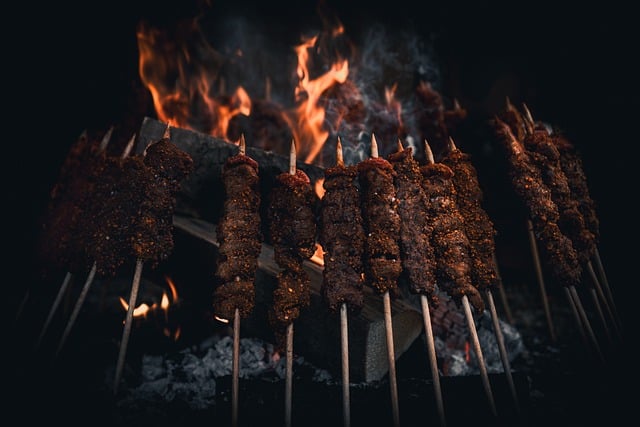Savor the Sizzle: Mastering the Art of Yakitori
Dive into the world of Japanese street food with yakitori, a mouthwatering grilled chicken skewer that's captivating taste buds worldwide. From its humble origins to modern interpretations, yakitori offers a tantalizing journey through flavor, texture, and culinary craftsmanship. Let's explore the secrets behind this beloved dish and discover why it's become a global sensation.

The Art of Skewer Selection
Mastering yakitori begins with understanding the diverse array of skewer options. While chicken is the star, the variety of cuts and preparations is astounding. Momo (thigh) and mune (breast) are popular choices for their tenderness and flavor. For the adventurous, nankotsu (cartilage) offers a uniquely crunchy texture, while hatsu (heart) provides a rich, intense taste. Negima, alternating pieces of chicken and green onion, is a classic combination that balances the meat’s richness with a fresh, aromatic bite. Each skewer type requires specific grilling techniques to achieve the perfect doneness. Skilled yakitori chefs consider factors like fat content, density, and cooking time to ensure each skewer reaches its full potential. This attention to detail elevates yakitori from simple street food to a culinary art form, showcasing the chef’s expertise and respect for ingredients.
Sauce Secrets: Tare and Beyond
The sauce is the soul of yakitori, with tare being the traditional choice. This sweet-savory glaze, typically made from soy sauce, mirin, sake, and sugar, is carefully brushed onto the skewers during grilling. The result is a glossy, caramelized exterior that enhances the chicken’s natural flavors. However, modern yakitori chefs are experimenting with innovative sauce variations. Yuzu kosho, a citrusy chili paste, adds a zesty kick, while miso-based glazes offer umami depth. Some chefs are even incorporating global influences, creating fusion sauces like garlic aioli or chimichurri to appeal to international palates. For purists, shio (salt) yakitori allows the chicken’s true flavor to shine through, seasoned with nothing more than high-quality sea salt. The key to great yakitori lies in balancing these flavors, ensuring the sauce complements rather than overwhelms the meat.
Grilling Techniques: From Traditional to High-Tech
The heart of yakitori lies in the grilling process, which has evolved from street-side charcoal grills to sophisticated restaurant setups. Traditional yakitori is cooked over binchotan, prized for its clean-burning properties and ability to reach high temperatures. This charcoal imparts a subtle smokiness while allowing the chicken’s natural flavors to shine. Modern yakitori chefs, however, are embracing technology to enhance their craft. Infrared grills offer precise temperature control, ensuring consistent results across large volumes of skewers. Some innovative restaurants are even experimenting with sous-vide techniques to pre-cook chicken before finishing it on the grill, resulting in incredibly juicy meat. Despite these advancements, the essence of yakitori remains unchanged – the skilled hand of the chef, turning and basting skewers to perfection, is still the most crucial element in creating outstanding yakitori.
Pairing Perfection: Drinks and Sides
While yakitori is undoubtedly the star, the supporting cast of drinks and side dishes plays a crucial role in the overall experience. Beer is a classic pairing, with its effervescence cutting through the richness of the grilled meat. For a more traditional approach, sake offers a range of flavor profiles that can complement or contrast with different yakitori styles. Non-alcoholic options like yuzu soda or cold barley tea provide refreshing counterpoints to the savory skewers. As for sides, simple dishes that don’t overshadow the yakitori are key. Edamame, pickled vegetables, or a light salad with a citrus dressing can cleanse the palate between skewers. Some yakitori-ya also serve ochazuke, a comforting dish of rice topped with green tea, as a satisfying end to the meal. The key is balance – creating a harmonious dining experience that enhances the yakitori without overwhelming it.
Yakitori Around the World
-
Yakitori-inspired dishes are appearing on menus globally, from food trucks to fine dining establishments
-
Some chefs are applying yakitori techniques to non-traditional ingredients like vegetables, seafood, or even fruit
-
Pop-up yakitori events in major cities are introducing this Japanese staple to new audiences
-
Home cooks are embracing yakitori, with specialized grills and ingredient kits becoming more widely available
-
Fusion creations like yakitori tacos or yakitori-topped pizzas are gaining popularity in trendy eateries
The global rise of yakitori showcases the universal appeal of this deceptively simple dish. From its humble origins in post-war Japan to its current status as a beloved cuisine worldwide, yakitori continues to evolve while maintaining its core essence. Whether enjoyed in a bustling Tokyo alley or a chic New York restaurant, yakitori offers a delicious glimpse into Japanese culinary tradition and innovation. As more people discover the joys of these flavorful skewers, yakitori’s future looks bright – and incredibly tasty.





